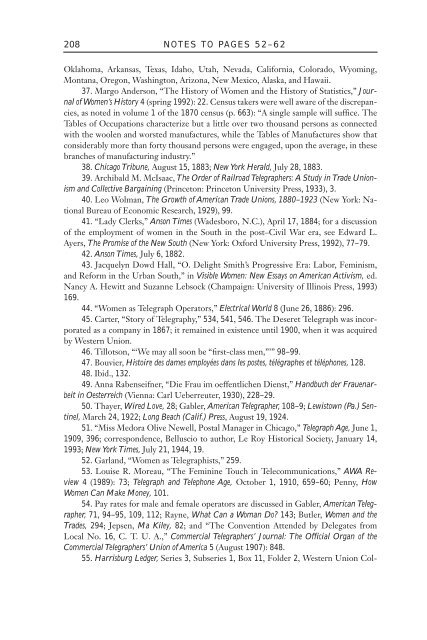My Sisters Telegraphic: Women in the Telegraph Office ... - Monoskop
My Sisters Telegraphic: Women in the Telegraph Office ... - Monoskop
My Sisters Telegraphic: Women in the Telegraph Office ... - Monoskop
You also want an ePaper? Increase the reach of your titles
YUMPU automatically turns print PDFs into web optimized ePapers that Google loves.
208<br />
NOTES TO PAGES 52–62<br />
Oklahoma, Arkansas, Texas, Idaho, Utah, Nevada, California, Colorado, Wyom<strong>in</strong>g,<br />
Montana, Oregon, Wash<strong>in</strong>gton, Arizona, New Mexico, Alaska, and Hawaii.<br />
37. Margo Anderson, “The History of <strong>Women</strong> and <strong>the</strong> History of Statistics,” Journal<br />
of <strong>Women</strong>’s History 4 (spr<strong>in</strong>g 1992): 22. Census takers were well aware of <strong>the</strong> discrepancies,<br />
as noted <strong>in</strong> volume 1 of <strong>the</strong> 1870 census (p. 663): “A s<strong>in</strong>gle sample will suffice. The<br />
Tables of Occupations characterize but a little over two thousand persons as connected<br />
with <strong>the</strong> woolen and worsted manufactures, while <strong>the</strong> Tables of Manufactures show that<br />
considerably more than forty thousand persons were engaged, upon <strong>the</strong> average, <strong>in</strong> <strong>the</strong>se<br />
branches of manufactur<strong>in</strong>g <strong>in</strong>dustry.”<br />
38. Chicago Tribune, August 15, 1883; New York Herald, July 28, 1883.<br />
39. Archibald M. McIsaac, The Order of Railroad <strong>Telegraph</strong>ers: A Study <strong>in</strong> Trade Unionism<br />
and Collective Barga<strong>in</strong><strong>in</strong>g (Pr<strong>in</strong>ceton: Pr<strong>in</strong>ceton University Press, 1933), 3.<br />
40. Leo Wolman, The Growth of American Trade Unions, 1880–1923 (New York: National<br />
Bureau of Economic Research, 1929), 99.<br />
41. “Lady Clerks,” Anson Times (Wadesboro, N.C.), April 17, 1884; for a discussion<br />
of <strong>the</strong> employment of women <strong>in</strong> <strong>the</strong> South <strong>in</strong> <strong>the</strong> post–Civil War era, see Edward L.<br />
Ayers, The Promise of <strong>the</strong> New South (New York: Oxford University Press, 1992), 77–79.<br />
42. Anson Times, July 6, 1882.<br />
43. Jacquelyn Dowd Hall, “O. Delight Smith’s Progressive Era: Labor, Fem<strong>in</strong>ism,<br />
and Reform <strong>in</strong> <strong>the</strong> Urban South,” <strong>in</strong> Visible <strong>Women</strong>: New Essays on American Activism, ed.<br />
Nancy A. Hewitt and Suzanne Lebsock (Champaign: University of Ill<strong>in</strong>ois Press, 1993)<br />
169.<br />
44. “<strong>Women</strong> as <strong>Telegraph</strong> Operators,” Electrical World 8 (June 26, 1886): 296.<br />
45. Carter, “Story of <strong>Telegraph</strong>y,” 534, 541, 546. The Deseret <strong>Telegraph</strong> was <strong>in</strong>corporated<br />
as a company <strong>in</strong> 1867; it rema<strong>in</strong>ed <strong>in</strong> existence until 1900, when it was acquired<br />
by Western Union.<br />
46. Tillotson, “‘We may all soon be “first-class men,”’” 98–99.<br />
47. Bouvier, Histoire des dames employées dans les postes, télégraphes et téléphones, 128.<br />
48. Ibid., 132.<br />
49. Anna Rabenseifner, “Die Frau im oeffentlichen Dienst,” Handbuch der Frauenarbeit<br />
<strong>in</strong> Oesterreich (Vienna: Carl Ueberreuter, 1930), 228–29.<br />
50. Thayer, Wired Love, 28; Gabler, American <strong>Telegraph</strong>er, 108–9; Lewistown (Pa.) Sent<strong>in</strong>el,<br />
March 24, 1922; Long Beach (Calif.) Press, August 19, 1924.<br />
51. “Miss Medora Olive Newell, Postal Manager <strong>in</strong> Chicago,” <strong>Telegraph</strong> Age, June 1,<br />
1909, 396; correspondence, Belluscio to author, Le Roy Historical Society, January 14,<br />
1993; New York Times, July 21, 1944, 19.<br />
52. Garland, “<strong>Women</strong> as <strong>Telegraph</strong>ists,” 259.<br />
53. Louise R. Moreau, “The Fem<strong>in</strong><strong>in</strong>e Touch <strong>in</strong> Telecommunications,” AWA Review<br />
4 (1989): 73; <strong>Telegraph</strong> and Telephone Age, October 1, 1910, 659–60; Penny, How<br />
<strong>Women</strong> Can Make Money, 101.<br />
54. Pay rates for male and female operators are discussed <strong>in</strong> Gabler, American <strong>Telegraph</strong>er,<br />
71, 94–95, 109, 112; Rayne, What Can a Woman Do? 143; Butler, <strong>Women</strong> and <strong>the</strong><br />
Trades, 294; Jepsen, Ma Kiley, 82; and “The Convention Attended by Delegates from<br />
Local No. 16, C. T. U. A.,” Commercial <strong>Telegraph</strong>ers’ Journal: The Official Organ of <strong>the</strong><br />
Commercial <strong>Telegraph</strong>ers’ Union of America 5 (August 1907): 848.<br />
55. Harrisburg Ledger, Series 3, Subseries 1, Box 11, Folder 2, Western Union Col-

















